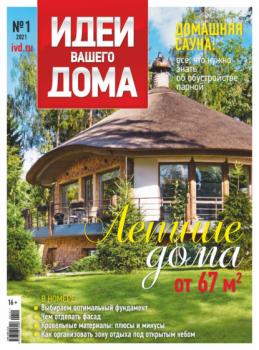Группа авторов
Список книг автора Группа авторовКараван историй №04 / апрель 2021
«Караван историй» – ежемесячный журнал, в котором публикуются материалы о ярких личностях, любовных историях знаменитостей, захватывающих приключениях и самых неординарных событиях века. Издание иллюстрируется эксклюзивными фотографиями, часто из личных архивов героев. «Караван историй» – это легкое, интересное и познавательное чтение. В номере: Искусство жить Эрик Булатов. Светлое и темное Денис Бургазлиев: «Сын для меня – центр Вселенной» Настроение Леонид Агутин: «Для многих посплетничать – физическая потребность. У меня ее нет» Имена Шарлотта Бронте. Маленькая Жанна д’Арк Факт Вокзал для двоих Гороскоп Астрологический прогноз на апрель и многое другое
О чем врачи вам не говорят №04/2021
Это российская версия популярного журнала о комплементарной и альтернативной медицине What doctors don’t tell you. Он признанный лидер среди изданий такой тематики не только у себя на родине, в Великобритании. Переведенный на несколько языков, он успешно продается еще в 14 странах мира. Главная цель журнала – помочь читателям сделать правильный выбор. Осознанный и продиктованный здравым смыслом. Получив достоверную информацию о нежелательных побочных эффектах той или иной терапии, а также о проверенных альтернативных методах лечения, врачи и пациенты смогут избежать повторения многих страшных ошибок, совершенных другими. Кстати, одновременно с результатами научных исследований на страницах журнала вы познакомитесь с реальными историями из жизни. Без них картина была бы неполной, а мы хотим, чтобы вы владели информацией по максимуму. Будьте здоровы! В номере: Место под солнцем Витамин D способен блокировать смертельные виды рака. Пищевая перезагрузка Повышаем энергетический потенциал. От печали до радости Полностью избавиться от тревоги невозможно, но можно научиться ее контролировать. Максимум пользы Частые ошибки в детском питании. Мужской фактор Чем дополнить лечение. Как лечат пчелы Апитерапия помогает избавиться от бессонницы, улучшить настроение, активизировать иммунитет. и многое другое
SALON-interior №04/2021
SALON-interior был создан в 1994 году и с момента основания публикует лучшие работы ведущих архитекторов, дизайнеров и декораторов, созданные в России и странах ближнего зарубежья. SALON-interior – авторитетный российский журнал по архитектуре и дизайну. Все новое, уникальное, эксклюзивное, что создается в стране, находит свое отражение в журнале, помогая читателям всегда быть в курсе современных тенденций российской архитектуры и дизайна. События, мировые выставки, обзоры аксессуаров, исторические здания, интервью с мировыми звездами, ландшафтные и флористические решения – все темы журнала призваны максимально информировать взыскательного читателя об увлекательном и творческом мире архитектуры и дизайна. В номере: Стать мягче Плюш и другие Новый мир Стиль modern: материалы, мебель, освещение Хранить лучшее Обзор мебели для гардеробных комнат Идеальный компромисс Минимализм с элементами классики Отпускное жильё Вилла в Неаполе с секретным садом внутри Крым ваш Отель Mriya Resort&Spa в окрестностях Ялты и многое другое
Playboy №1/2021
Playboy (Плейбой) – имя, ставшее легендой. Популярнейший во всем мире глянцевый мужской журнал появился в России в 1995 году и очень быстро стал самым востребованным изданием в своей категории. Playboy охватывает очень широкий тематический спектр: самые красивые женщины мира, эффектные пикториалы и эксклюзивные съемки знаменитостей, увлекательные путешествия по всему миру, престижные автомобили, эффектная мужская мода. Интеллектуальная проза, интервью с известными мужчинами – о бизнесе, увлечениях и отношении к жизни. Получать удовольствие, уметь находить во всем приятные стороны – эти жизненные ценности актуальны для мужчин во все времена. Playboy – это стильные фото и публикации о музыке, спорте, автомобилях, аудиовидеоновинках, сексе, карьере. В номере: Персона Джефф Безос – правила жизни Интервью Стив Джобс: «Мы формируем будущее» Кухня Крутые яйца и уроки мексиканского Взгляд Митя Фомин и его авторское эссе о будущем в настоящем Архив Джим Керри: одинокий монах, которому чужды все блага популярности Новинки 7 предметов, которых тебе так не хватало в ванной комнате и многое другое
Добрые советы. Люблю готовить! №04/2021
«Добрые советы. Люблю готовить!» – журнал о вкусной еде, не похожий на другие кулинарные издания. Все опубликованные в нем рецепты присланы в редакцию самими читателями. Каждый рецепт прошел конкурсный отбор, а его автор получил денежный приз. Ежемесячно на страницах журнала – более 100 коронных блюд, которые многократно проверены опытными хозяйками и которые можно смело брать в свою коллекцию рецептов тем, кто любит баловать родных и удивлять гостей. С помощью журнала легко составить меню полноценного обеда или приготовить ужин на скорую руку, соблюдать пост или устраивать пышные застолья. А еще – в совершенстве овладеть кулинарным искусством под руководством шеф-повара, который дает в каждом номере несколько мастер-классов! Тема номера: На скорую руку.
Журнал «Лиза» №13/2021
Самый популярный в России еженедельный журнал для молодых женщин «Лиза»! Фитнес со звездой и звездный макияж, уроки стиля и самые горячие новости из жизни кумиров. А еще – модный шопинг, актуальная мода, новинки косметики и великолепные идеи для дома. Романтические истории о настоящей любви и рассказы читательниц о разных жизненных ситуациях. Аспекты психологии, секреты успешных отношений с окружающими и искусство сохранения любви. Консультации экспертов в области медицины и богатства природной аптеки. Лучшие кулинарные рецепты из редакционной коллекции. Увлекательные путешествия по России и всему миру.
Журнал «Лиза» №12/2021
Самый популярный в России еженедельный журнал для молодых женщин «Лиза»! Фитнес со звездой и звездный макияж, уроки стиля и самые горячие новости из жизни кумиров. А еще – модный шопинг, актуальная мода, новинки косметики и великолепные идеи для дома. Романтические истории о настоящей любви и рассказы читательниц о разных жизненных ситуациях. Аспекты психологии, секреты успешных отношений с окружающими и искусство сохранения любви. Консультации экспертов в области медицины и богатства природной аптеки. Лучшие кулинарные рецепты из редакционной коллекции. Увлекательные путешествия по России и всему миру.
Идеи Вашего Дома №1/2021
Журнал «Идеи Вашего Дома» – ведущее российское издание по вопросам ремонта и обустройства интерьера – выходит с 1997 года. Читатели журнала – это, прежде всего, люди со средним и выше среднего уровнем достатка, планирующие реконструкцию, ремонт, дизайн интерьера своего жилья с привлечением квалифицированных специалистов. Журнал «Идеи Вашего Дома» предлагает большое количество планировочных и оформительских решений, обзоры ремонтно-строительных материалов, мебели, техники и оборудования. Читатель найдет в журнале достоверную и независимую информацию о новых товарах и услугах, современных материалах и известных торговых марках. В номере: Буква закона Управление садовым товариществом (как работают органы власти СНТ) Дом снаружи и внутри Чтобы цоколь не мёрз (как утеплить цоколь здания) Хранящие чистоту (самоочищающиеся фасадные штукатурки) Чем тебя укрыть? (самые популярные кровельные материалы для скатных крыш) Домашние тропики (как обустроить сауну в доме: отвечаем на вопросы) Сад и участок Разбить лужайку (устройство газона без серьёзных усилий и затрат) Каменный остров (оформление зоны барбекю искусственным камнем) и многое другое
Burda Special №03/2021
Тема этого номера – «Моё солнышко». В этом выпуске: Cогревающие лучи солнца пробиваются сквозь облака, на деревьях скоро появится нежная зелень, и мы вдыхаем этот удивительный ароматный воздух. Пришла весна! Для первых теплых дней и жаркого лета мы выбрали самые популярные модели: спортивные брючки и пуловеры, воздушные платья и блузки, удобные комбинезоны (размеры от 104 до 146). Все продумано с большой любовью: отделка из нежного кружева и легкие натуральные ткани, такие как хлопок и лен. Комфорт, как всегда, на высоте. Дети с наслаждением будут бегать по травке и лазать по деревьям. А вам желаем получить настоящее удовольствие во время шитья и веселых примерок! Все выкройки Burda вы сможете найти на сайте журнала: http://burdastyle.ru/vikroyki/ .
Наука и жизнь №03/2021
«Наука и жизнь» – ежемесячный научно-популярный журнал для всех возрастов и профессий. На страницах журнала: новости науки и техники, статьи по истории, биологии, физике, медицине, искусствоведению, научно-фантастические рассказы, материалы традиционных рубрик: «Мир увлечений», «Кунсткамера», «Маленькие хитрости». Для школьников есть специальный раздел «Ума палата». На портале журнала http://www.nkj.ru : новости науки и техники, видео, архив, интервью, on-line кроссворды. В номере: Вакцина: организм должен запомнить болезнь, не болея Весна – это лучшее время для наблюдения знакомых всем семи ярких звёзд! Слышать, видеть, предугадывать – главная задача фотографа-натуралиста В языковой Вселенной Лескова диковинные обновлённые слова – ярче звёзд и комет! и многое другое









